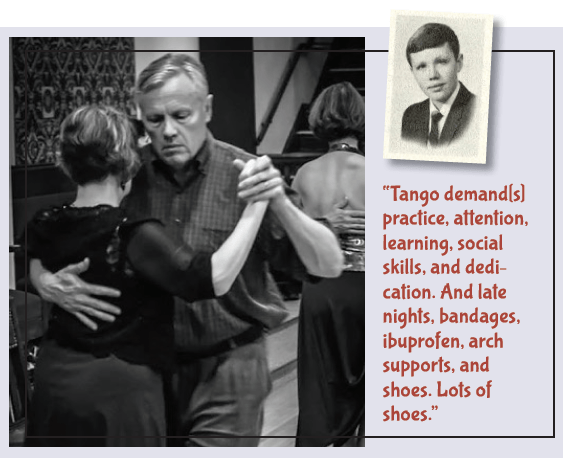
Tango is about connection and grace, sadness and hope, and moments of believing there is nothing else.
When my wife Betsy Henderson and I married, she was an active dancer. She did swing, contra, and folk dance, attending various camps and workshops. My dance experience was nil. While I attempted to join her in various dance activities, nothing stuck. I got to watch or stay home.
However, in 2003, Betsy suggested we go see a public tango demonstration. It seemed interesting and approachable…and exotic. I bought lessons for her, rather us, for Valentine’s Day. At the first lesson, after simple steps, as well as descriptions of tango from the instructors, and with no inherent skill whatsoever, I was hooked.
What we had entered was a completely different world, one unknown to the rest of society. It demanded practice, attention, learning, social skills, and dedication. And late nights, bandages, ibuprofen, arch supports, and shoes. Lots of shoes.
To become competent, it’s said, takes two years for a follower, generally a woman. And it will take six years for a leader, with practice, to reach the same level. The roles of leader and follower are well defined. The leader asks a follower to dance by a glance or nod of the head, a cabeceo, and it is accepted by a similar nod. They dance a full tanda, or a set of music, three or four songs, and when it’s over they go their separate ways. If, however, it is clear that one’s partner is mismatched or a bad dancer, a “thank you” after one song ends their dancing together.
Tango is challenging; you are seeking the magic moments when it works for both leader and follower. The rare seconds of a good dance reach a state of flow, often called a tango moment. And when you notice it, it’s gone.
On the other hand, a good set of music, building from the first song, synchronized and engaged, is evocative and passionate. It has been described as a “three-minute affair.”
On my first visit to Buenos Aires, we went to an afternoon dance, called a milonga. The average age of the participants was over 75, and it appeared they were regulars and danced every day. I mused that it was a great retirement plan: socializing, exercise, camaraderie, wine, and dance partners of every age.
While we have been back to Buenos Aires multiple times, tango has served as an introduction for my wife and me anywhere around the world. I’ve danced in Copenhagen, Los Angeles, Japan, Cardiff; her dance episodes have ranged to Singapore, Hawaii, Hong Kong, and Taiwan.
In Stockholm we learned of a small milonga south of the city center. We took the metro close to the location, heard classic tango music and walked in, carrying our dance shoes. After a few sets together, we both sought out other dance partners. I nodded to a woman and we danced the first song of a tanda. On the break she began speaking in Swedish. After my stuttered response, she quickly switched to English. Less translation had been needed with tango, por supuesto.
This past year has been a challenging one for the tango community around the world. In Buenos Aires, where regularly there were 20 scheduled milongas each day, the city has gone still or covert. We danced the last in Minnesota over one year ago before a rapid shutdown. We had built our network of friends as well as my wife’s clothing design business, Betsy Henderson Designs on tango, and with the pandemic, both have been seriously affected.
We are waiting for a nod.
— Brad Hokanson